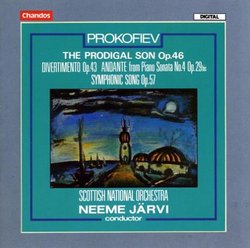| All Artists: Sergey Prokofiev, Neeme Jarvi, Scottish National Orchestra Title: Sergey Prokofiev: The Prodigal Son, Op. 46, Ballet in Three Scenes by Boris Kochno / Divertimento, Op. 43 / Andante, from Piano Sonata No. 4, Op. 29 bis (Transcription by the Composer for Orchestra) / Symphonic Song, Op. 57 - Neeme Järvi Members Wishing: 0 Total Copies: 0 Label: Chandos Release Date: 10/28/1992 Genre: Classical Styles: Ballets & Dances, Ballets, Forms & Genres, Sonatas, Historical Periods, Modern, 20th, & 21st Century, Symphonies Number of Discs: 1 SwapaCD Credits: 1 UPC: 095115872826 |
Search - Sergey Prokofiev, Neeme Jarvi, Scottish National Orchestra :: Sergey Prokofiev: The Prodigal Son, Op. 46, Ballet in Three Scenes by Boris Kochno / Divertimento, Op. 43 / Andante, from Piano Sonata No. 4, Op. 29 bis (Transcription by the Composer for Orchestra) / Symphonic Song, Op. 57 - Neeme Järvi
CD DetailsSimilar CDs
|
CD ReviewsLittle Known But Great Music D. A Wend | Buffalo Grove, IL USA | 06/04/2003 (5 out of 5 stars) "This is among my favorite discs of Sergei Prokofiev's music, one that I
play frequently. The music recorded here is, for the most part, unfamiliar. The Prodigal Son, despite its popularity, does not have many recordings. This is among the best and truly brings out the emotion lying behind the music of Prokofiev's own yearnings to return to his native Russia. The Prodigal Son also marks a stage in Prokofiev's quest for a simplification of his music that came to fruition when he returned to the Soviet Union in 1936. This ballet was among the last performed by the Ballet Russes, and among the most successful. Although based on the story from the Gospel of St. Luke, the ballet departs from the story by omitting the elder brother and being more descriptive of the temptations and tumult the prodigal son encounters; the Siren was a figure entirely made up. The ballet can be said to reflect Prokofiev's own feelings on living in the West, where he found his music accepted with some reluctance. The feeling of having strayed into trouble and being forgiven that is embodied in the music caused the opening night audience to shed a few tears. So when the Prodigal Son returns to his father in the last scene of the opera, humbling himself, it is Prokofiev himself thinking of his return home.The remaining works are different in their dissonance from The Prodigal son but date from the early 1930s. They are based, for the most part, on earlier material. The Divertimento has material used in a quintet-ballet called Trapeze and the Andante from the 4th piano sonata dates from 1917. Only the dissonant Symphonic Song of 1933 was based on new material. These short works are of great interest but never achieved much fame. The music is fabulously played by the Scottish National Orchestra and the recording by Chandos is crystal clear. One must thanks Nemi Jarvi for his interest in little-played works for this highly interesting CD." |


 Track Listings (16) - Disc #1
Track Listings (16) - Disc #1


